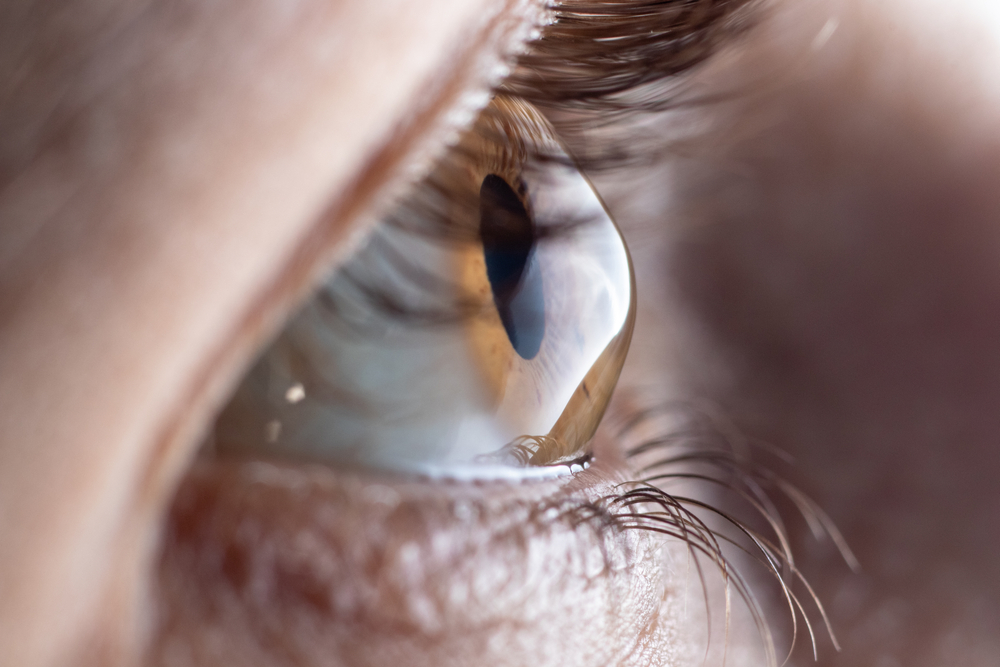
Have you been diagnosed with an eye condition like keratoconus or corneal ectasia? These corneal conditions can occur if the cornea cannot function properly.
The talented and experienced ophthalmologists at Georgia Eye Physicians & Surgeons treat corneal conditions to ensure your eyes are healthy and help you see the world clearly around you.
The cornea is the eye’s outermost protective barrier and is the transparent coating covering your iris and pupil. The cornea is dome-shaped and allows light to enter the eye.
It focuses rays of light onto the retina in the back of your eye, allowing you to see clearly. At approximately the thickness of a nickel, the cornea provides much of the eye’s ability to focus.
Because of this, it must always be in perfect clarity and keep its exact curvature to ensure images are correctly focused in your eye.
To function correctly, the cornea consists of five layers. These layers are carefully constructed and help maintain its transparency and ability to bend light.
Each layer of the cornea has a distinct function and ensures that the cornea works as it should. If any of these layers becomes misaligned, flooded, or swollen, the cornea loses its clarity and ability to focus. The result is blurry, distorted vision.
Common corneal conditions treated at Georgia Eye Physicians & Surgeons include:

Keratoconus is an eye condition in which the cornea becomes too thin, leading to outward protrusion. This results in the cornea becoming more cone shaped as it loses its structural integrity.
It typically affects patients in puberty and progresses into the mid-thirties. Patients with keratoconus often experience symptoms like double vision, substantial glare, increasing nearsightedness, and irregular astigmatism as vision worsens.
In the early stages of keratoconus, rigid gas-permeable contact lenses can help improve vision. However, treatments like corneal collagen cross-linking may be appropriate during the early stages to strengthen the cornea and slow keratoconus progression.
iLink corneal cross-linking is the only FDA-approved cross-linking procedure for treating progressive keratoconus. Corneal cross-linking, or corneal collagen cross-linking, is a specialized treatment that treats corneal conditions like keratoconus and corneal ectasia. The treatment strengthens the cornea and helps slow down the progression of these conditions.
It does this by introducing new bonds within the corneal collagen and stiffening the cornea to help it hold its shape. Corneal cross-linking uses vitamin B2 eye drops and then exposure to UV light.
This combination activates new cross-links between the collagen molecules, making the cornea more stable. Cross-linking reinforces the cornea and halts further progression of symptoms of corneal conditions like keratoconus, which include abnormal bulging of the eyes and irregular astigmatism.
Corneal cross-linking works best in the early stages of these conditions before symptoms are too advanced. Corneal cross-linking cannot reverse damage to the cornea that has already occurred, making it crucial to undergo the procedure before significant damage to maintain the cornea’s shape and curvature.
Pterygium is a corneal condition often due to too much time spent in the sun without proper protection, like sunglasses or a wide-brimmed hat. It refers to a wedge-shaped fleshy growth that usually develops on the white of the eye near the cornea.
A pterygium can become red and irritated as it spreads across the cornea.
A pterygium can reduce your visual clarity by blocking incoming light from focusing as it should through your pupil.
Treating pterygium can include several methods, including steroid and lubricating eye drops to reduce inflammation, antiviral eye drops if the pterygium continues to develop, or surgery to remove the pterygium. Surgery usually becomes necessary if the pterygium is blocking your vision or causing significant irritation.
Corneal ulcers are a condition that occurs when infections erode through the cornea’s protective surface layer, creating an open wound in the eye. Common causes of corneal ulcers include bacterial, fungal, and viral infections.
You’ll need medication and specialty contact lenses to ensure proper healing if you have a corneal ulcer. Symptoms of a corneal ulcer include increased sensitivity to light, severe eye pain, blurred vision, a foreign body sensation in the eye, tearing, and redness.
Quickly diagnosing and treating corneal ulcers is necessary to avoid permanent vision loss due to corneal scarring or holes in the cornea.
Corneal ectasia is a group of disorders involving abnormal corneal thinning and forward protrusion. Because of this, light bends incorrectly.
Vision becomes blurrier due to irregular astigmatism, and patients with corneal ectasia may see multiple images. Patients may develop corneal ectasias after a procedure like LASIK if they have an underlying architectural instability discovered after reshaping tissue in the cornea to correct refractive errors and correct vision.
The skilled and experienced team of ophthalmologists at Georgia Eye Physicians & Surgeons offer the following treatment options for corneal conditions:
A corneal transplant, which may also be called corneal grafting or keratoplasty, is a procedure that surgically replaces damaged corneal tissue with healthy donor tissue. Removing and replacing this corneal tissue restores vision.
Corneal transplants are usually only deemed necessary if significant vision loss cannot be improved in other ways, like using glasses, medications, or undergoing other procedures. There is more than one kind of corneal transplant, and depending on the severity of corneal damage, your Georgia Eye Physicians & Surgeons ophthalmologist may recommend one over the other.
A full-thickness corneal transplant replaces the entire central cornea with donor tissue. This is usually necessary if all layers of the cornea are compromised.
During the procedure, your surgeon will replace the damaged cornea with a full-thickness donor graft to improve your vision and ability to see clearly.
A partial thickness corneal transplant is often recommended if only specific layers of the cornea are affected. Performing this kind of cornea transplant allows your surgeon to selectively replace diseased layers as much as possible.
A partial thickness corneal transplant, or lamellar keratoplasty, only transplants the layer of corneal tissue requiring replacement. Doing this preserves unaffected layers and healthy surface cells in the cornea.
Undergoing a corneal transplant, full or partial thickness, is a way of achieving improved vision. However, you’ll likely still have a refractive error, requiring glasses and contact lenses.
Corneal transplants are an excellent way of reversing vision loss and improving vision that cannot be treated in other ways.